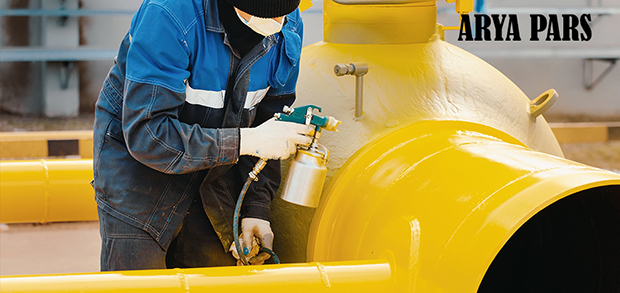Acrylic Paint
Acrylic paints are made based on acrylic resins. These paints are formulated and produced in two categories: solvent-based and water-based. Water-based acrylic paints are highly compatible with the environment and can be a suitable alternative to the usual alkyd oil paints used in architectural painting. High adhesion, anti-moisture properties, and the variety of finishes and color families in acrylic paints have caused these paints to be used on different surfaces.
Acrylic paint is applied and used on different surfaces such as plaster, concrete, cement and metal surfaces. As mentioned, water-based acrylic paint is environmentally friendly and currently it is produced and supplied in large quantities in different colors. Water-based acrylic paint dries quickly, forming a hard surface. Although these paints may not match the thickness and color brilliance of alkyd or solvent-based acrylic paints, their high concentration is used to create texture on the dry film surface, making them very suitable.
Acrylic products of Arya Sath Tehran Company are formulated as water-based acrylics and are environmentally friendly. They are produced in matte, semi-gloss, and glossy finishes. Generally, these paints are well-known in the construction paint family and are packaged in gallons and plastic buckets, with the base colors also available in quart-sized packaging in stores. Acrylic paints produced by Arya Sath Tehran Company are divided into different glosses for interior and exterior spaces, as well as primers, etc., which are mentioned below.
General classification of water-based acrylic paints includes:
- Acrylic building facade paint (water-based)
- Matte and semi-gloss acrylic paint (water-based)
- Acrylic water-based primer (Arya priming).
- Acrylic water-based sealer (undercoat)
- Acrylic water-based stain killer
- All-purpose acrylic putty
- Various mother colors of acrylic paints
Properties and Some Applications of Water-Based Acrylic Paint
- Soluble Acrylic Paint for Facade (Water-based)
This paint is designed based on water-soluble acrylic resin. The product is used on surfaces such as plaster, brick, concrete, and cement in the exterior of buildings. Some of its general properties include excellent adhesion, fast drying, high wear resistance, no dust absorption, and quick and easy water cleaning (Self-Cleaning), distinguishing it from plastic paints. It is recommended to use epoxy concrete primer as the first layer to increase the lifespan, beauty, and uniformity of the resulting film.
- Water-Based Acrylic Paint (Matte and Semi-Gloss)
This paint is designed based on water-soluble acrylic resin. It is used on surfaces such as plaster, brick, concrete, and cement in the interior space of buildings. Some of its general properties include excellent adhesion, fast drying, high wear resistance, no dust absorption, and quick and easy water cleaning (Self-Cleaning), distinguishing it from plastic paints.
- Water-Based Acrylic Primer
This product is designed based on acrylic resin, which due to its proper viscosity and penetration properties, has high wetting power in the created profiles of the desired executive surfaces, and due to its special design, it has high adhesion to various surfaces, such as concrete and brick. It can be called as the most suitable bridge between the underlying surfaces and subsequent layers. Other properties include suitable wear resistance, no dust absorption, and quick and easy water cleaning.
Paint Application Conditions
Surface Preparation
- The intended surface should be free from any contamination. To achieve this, methods such as air pressure application, washing with detergents, and thinners (appropriate to the painting system, desired service life, weather conditions, and surface material) can be used.
- Painting should be done immediately after preparing the surface. The surface must be completely dry and free from moisture.
Painting Environment Conditions
- The optimal temperature of the environment and work surface during painting is between 10-40 degrees Celsius. It is recommended for achieving proper quality.
- Painting should ideally be done in covered environments. The ambient temperature during painting should be at least 3 degrees Celsius above the dew point of the environment to prevent water droplets from forming on the surface.
Water-Based Acrylic Paint Application Method
- Prepare and use according to the technical specifications of each paint, depending on the type of spraying and the required thinner.
Painting Equipment
- Airless spray with a nozzle diameter of 0.013-0.015 inches
- Air spray (conventional) with a nozzle diameter of 1.5-2 mm and pressure of 3-5 atmospheres
- Brush and roller, equipment that can be used for painting.
follow by instagram arya sath tehran
Other Products

Alkyd Paint

Epoxy Paint




Leave a Reply